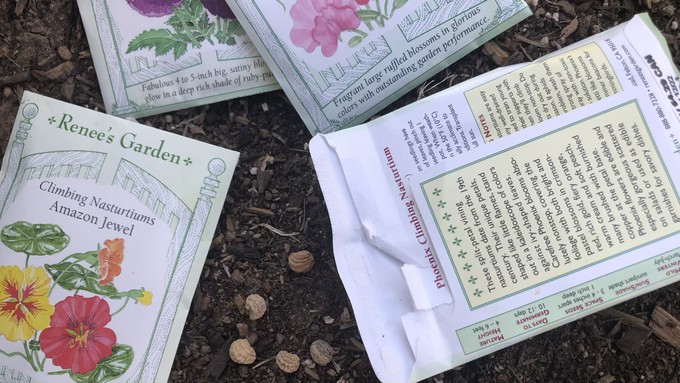
More pleasant days are expected; time to get things done

Plant nasturtiums, poppies, sweet peas and other flower seeds now for blooms in early spring. Kathy Morrison
Thinking about making some landscape renovations? Now may be the right time to pick up your shovel and get to work.
October is ideal for planting trees, shrubs and perennials in our area. Soil is still warm and helps roots grow strong before the chill (and stress) of winter sets in. And pleasant daytime temperatures entice gardeners to get outside – and get busy.
According to the National Weather Service, Sacramento can expect the last of the 90-degree-plus days on Monday, with high temperatures dropping slightly into the upper 80s for the rest of the week. Normal high for this second week of October is 82 degrees. Night-time lows continue in the mid 50s – in other words, perfect fall weather.
Just make sure whatever you transplant receives enough moisture. Give plants a deep soaking so they can settle in and get growing.
These warm days and nights will prompt summer vegetables such as tomatoes and peppers to keep producing a little while longer. Thanksgiving tomatoes are possible.
Warm nights also will keep leaves green. Fall foliage with its rich golds and oranges won’t show up until later this month when overnight temperatures dip into the low 40s. Judging by the 30-day forecast, that may not be until sometime around Halloween.
* Clean up the summer vegetable garden and compost disease-free foliage.
* Harvest pumpkins and winter squash as they mature.
* Dig up corms and tubers of gladioluses, dahlias and tuberous begonias after the foliage dies. Clean and store in a cool, dry place.
* Treat azaleas, gardenias and camellias with chelated iron if leaves are yellowing between the veins.
* Chill tulip and hyacinth bulbs in the refrigerator before planting. They need about six weeks of cold before going in the ground.
* Want early spring flowers? Plant seeds for cornflower, nasturtium, nigella, poppy, portulaca, sweet pea and stock.
* Plant seeds for radishes, bok choy, mustard, spinach and peas.
* Plant garlic and onions.
* Set out cool-weather bedding plants, including calendula, pansy, snapdragon, primrose and viola.
* Reseed and feed the lawn. Work on bare spots.
Comments
0 comments have been posted.Sacramento Digs Gardening to your inbox.
Sites We Like
Garden Checklist for week of July 21
Your garden needs you!
* Keep your vegetable garden watered, mulched and weeded. Water before 8 a.m. to reduce the chance of fungal infection and to conserve moisture.
* Feed vegetable plants bone meal, rock phosphate or other fertilizers high in phosphate to stimulate more blooms and fruiting. (But wait until daily high temperatures drop out of the 100s.)
* Don’t let tomatoes wilt or dry out completely. Give tomatoes a deep watering two to three times a week.
* Harvest vegetables promptly to encourage plants to produce more. Squash especially tends to grow rapidly in hot weather. Keep an eye on zucchini.
* Pinch back chrysanthemums for bushy plants and more flowers in September.
* Remove spent flowers from roses, daylilies and other bloomers as they finish flowering.
* Pinch off blooms from basil so the plant will grow more leaves.
* Cut back lavender after flowering to promote a second bloom.
* It's not too late to add a splash of color. Plant petunias, snapdragons, zinnias and marigolds.
* From seed, plant corn, pumpkins, radishes, winter squash and sunflowers.